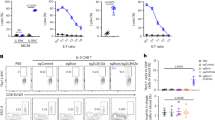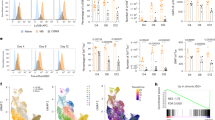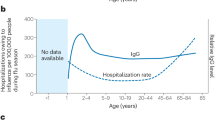Abstract
THE reactivity of thymus-derived (T) lymphocytes when stimulated with the phytomitogens phytohaemagglutinin (PHA), concanavalin A (con A) and pokeweed mitogen (PWM), correlates well with immunological reactivity. Consequently, the mitogens have been useful in studies of the functional maturity of thymocytes in foetal and neonatal mice. Reactivity to con A and PWM increases greatly during the perinatal period, but PHA responsiveness reaches a peak shortly before birth and then declines3. This decline could be due to either (1) reversible suppression of PHA-responsive thymocytes by PHA-unresponsive cells; or (2) the emigration or death of PHA-reactive cells or the immigration or expansion of a population of PHA-unresponsive cells. If PHA-responsive thymocytes in the newborn mouse are all steroid resistant, as seems to be the case in the adult4,6, then steroid treatment of newborns might aid the choice between possibilities (1) and (2). If (1) is correct, steroid treatment should cause a greater increment in thymocyte PHA responsiveness than could be explained by the increased relative number of highly reactive steroid-resistant cells. If (2) is correct, steroid treatment should increase PHA-responsiveness in proportion to the increase in relative number of PHA-responsive cells. If, however, all PHA-responsive cells are eliminated, steroid treatment should not increase PHA responsiveness. This possibility is given some support by a report5 involving techniques different from ours. We have therefore attempted to characterise the fraction of thymocytes surviving steroid treatment in the newborn mouse with regard to mitogen reactivity, reactivity in the mixed lymphocyte reaction (MLR), and surface representation of the θ alloantigen. We found that steroid treatment increased the PHA responsiveness of newborn thymocytes, supporting explanation (2).
This is a preview of subscription content, access via your institution
Access options
Subscribe to this journal
Receive 51 print issues and online access
$199.00 per year
only $3.90 per issue
Buy this article
- Purchase on Springer Link
- Instant access to full article PDF
Prices may be subject to local taxes which are calculated during checkout
Similar content being viewed by others
References
Miller, J. F. A. P., and Mitchell, G. F., Transplantn Rev., 1, 3 (1969).
Claman, H. N., and Chaperon, E. A., Transplantn Rev., 1, 92 (1969).
Mosier, D. E., J. Immun., 112, 305 (1974).
Blomgren, H., and Andersson, B., Expl Cell Res., 57, 185 (1969).
Howe, M. L., and Manziello, B., J. Immun., 109, 534 (1972).
Blomgren, H., and Svedmyr, E., Cell. Immun., 2, 285 (1971).
Mosier, D. E., and Pierce, C. W., J. exp. Med., 136, 1484 (1972).
Boyse, E. A., Miyazawa, M., Aoki, T., Old, L. J., Proc. R. Soc., B 170, 175 (1968).
Owen, J. J. T., and Raff, M. C., J. exp. Med., 132, 1216 (1970).
Author information
Authors and Affiliations
Rights and permissions
About this article
Cite this article
COHEN, P., MOSIER, D. Reactivity of steroid-resistant neonatal thymocytes. Nature 251, 233–234 (1974). https://doi.org/10.1038/251233a0
Received:
Issue Date:
DOI: https://doi.org/10.1038/251233a0
Comments
By submitting a comment you agree to abide by our Terms and Community Guidelines. If you find something abusive or that does not comply with our terms or guidelines please flag it as inappropriate.



